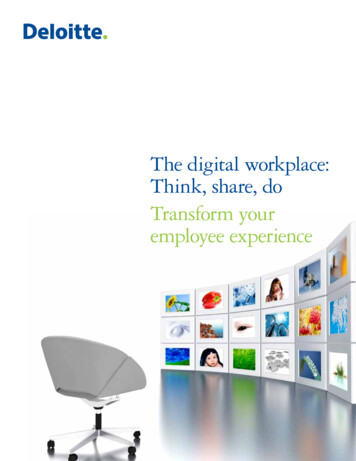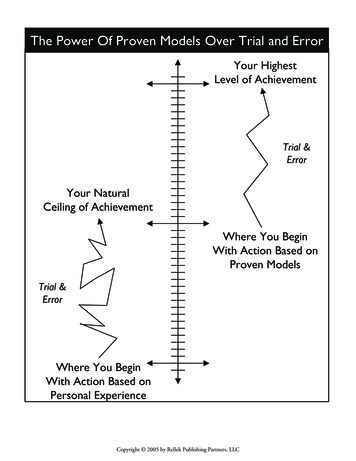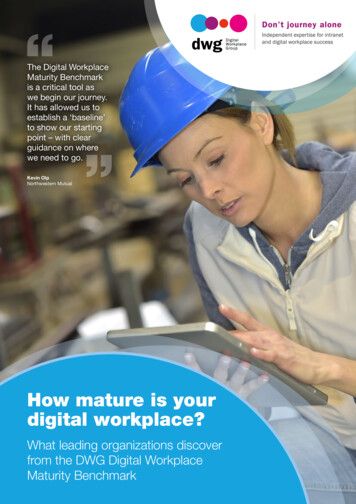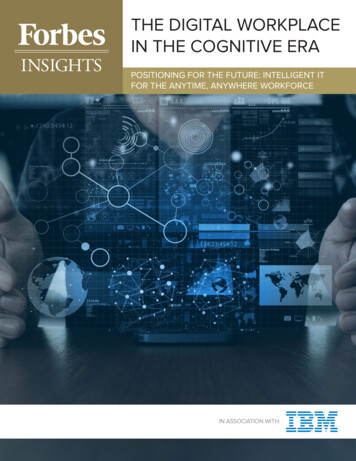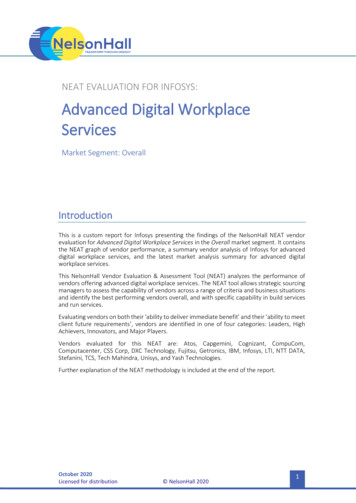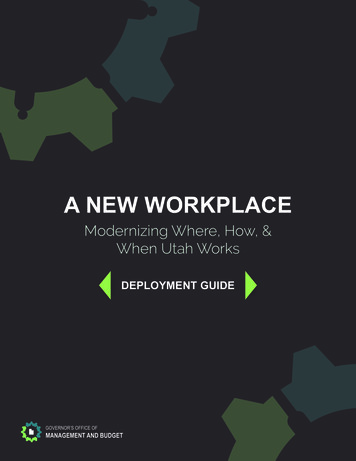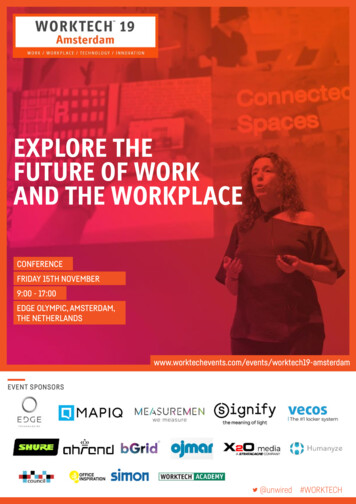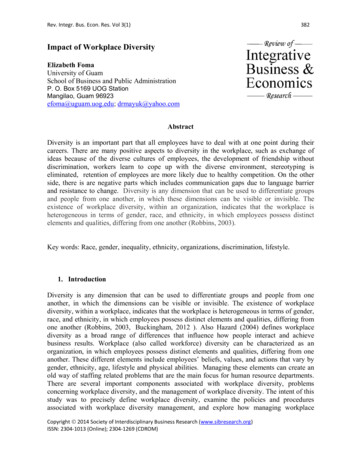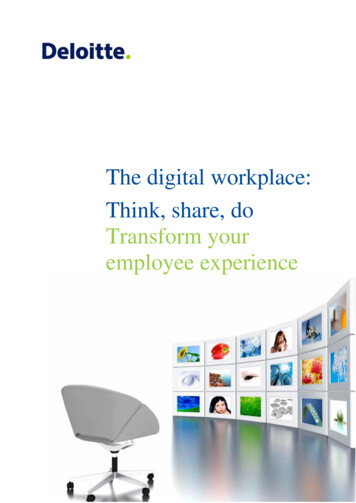
Transcription
The digital workplace:Think, share, doTransform youremployee experienceThe digital workplace: Think, share, do1
2The digital workplace: Think, share, do
Gone are the days when the workplace was merely a physical spaceemployees occupied during regular office hours. Today's alwaysconnected, instant access environment has blurred the linesbetween the physical office and the place where work actuallyhappens. As the distinction between professional and personal lifedissolves, and the workplace becomes truly digital, employees arecommunicating and collaborating in unprecedented ways. Toenable knowledge sharing across the organization, they want theability to forge productive business relationships beyond naturalwork groups. As a result, it is increasingly clear that the traditional'create and push' information approach no longer meets employees’evolving needs.To accurately reflect their staff’s changing work experience,leading organizations have begun to implement an entirely newworking environment – the digital workplace. By integrating thetechnologies that employees use (from e-mail, instant messagingand enterprise social media tools to HR applications and virtualmeeting tools), the digital workplace breaks down communicationbarriers, positioning you to transform the employee experience byfostering efficiency, innovation and growth. The key to success,however, lies in the effective implementation of a digital workplacestrategy capable of driving true cultural change.The digital workplace: Think, share, do3
4The digital workplace: Think, share, do
Embrace the evolutionTrack changing trendsWhile the workplace began transforming as far back asthe agricultural and industrial revolutions, thewidespread proliferation of information technologyforever changed the ways in which employees connect,collaborate and communicate.This change accelerated over the last 30 years due tothe emergence of three fundamental trends: Changing workforce: As the baby boomers retire, knowledge is leaving thecompany, increasing the need to capture it. On theother side the new generation of workers is very ITsavvy and expect to have flexible easy to use toolsjust as they have in their private life. . Information overload: information is still growing atexponential rates and employees can’t find what theyneed, even with technology advances. The need for speed: with the rapid pace of today’swork environment, employees increasingly need towork faster and collaborate more effectively to gettheir jobs done.As workplace demographics continue to shift,employers struggle to meet the varying needs of amulti-generational workforce. As the use of the Internetand mobile devices grows, the pace of changecontinues to accelerate. These changes are furtherexacerbated by ongoing demands to increaseproductivity and cut costs, making it harder foremployees to meet market expectations. Together,these trends are reshaping the work environment.Respond to changeThe emerging digital workplace can address theseconcerns by helping organizations: Support changes in working styles that enableemployees to work more transparently and betterleverage social networks. Unify offline and online communications bykeeping employees connected through their mobiledevices to provide anywhere, anytime access to toolsand corporate information. Focus on employee experience by providing themwith user experience they have outside the firewall. Provide choice, flexibility and personalization. Support virtual work environments that allowemployees to stay connected in distributed andvirtualized work locations while balancing customerprivacy and operational risk. Minimize spending and enhance productivity byproviding employees with the right tools and rightinformation at the right time. Win the war on talent by offering the progressiveand innovative environments that top candidates nowexpect.The digital workplace: Think, share, do5
Define the digital workplaceWhat is a digital workplace?Why adopt a digital workplace strategy?The digital workplace can best be considered as thenatural evolution of the workplace. Comprised of youremployees’ technology working environment.If the risks of inaction are not sufficient motivators, thebenefits of adopting a digital workplace make acompelling business case. Consider the gains in:The digital workplace encompasses all thetechnologies people use to get work done in today’sworkplace – both the ones in operation and the onesyet to be implemented. It ranges from your HR applications and core businessapplications to e-mail, instant messaging andenterprise social media tools and virtual meeting tools.Because most organizations already use many of thesecomponents, you generally do not have to build thedigital workplace from the ground up. In fact, if yourstaff respond to e-mails from smartphones, check theirpay stubs online or digitally enter a sales opportunity,you may be closer to operating a digital workplace thanyou think.Yet even in cases where new technologies arerequired, the benefits increasingly outweigh the costs.As the workplace continues to evolve, and employeeexpectations shift, organizations that do not embracethe digital workplace risk falling behind. Talent attraction: 64% of employees would opt for alower paying job if they could work away from theoffice.1Employee productivity: organizations with strongonline social networks are 7% more productive thanthose without.2Employee satisfaction: organizations that installedsocial media tools internally found a median of 20%increase in employee satisfaction.3Employee retention: when employee engagementincreases, there is a corresponding increase inemployee retention by up to 87%.4Communication tools: information workers prefernewer communication tools, particularly instantmessaging, over more traditional ones like e-mail orteam workspaces.5Given these advantages, more organizations arecommitting IT budget on supporting digital workplacestrategies that promise to deliver measurable returns.This trend is only set to accelerate as employeesincreasingly choose to forge productive businessrelationships beyond natural work groups in an effort toenhance knowledge sharing across the organization.To support these outcomes, you need to provideemployees with the tools they require to collaborate,communicate and connect with each other and yourback-end systems. You need to coordinate yourtechnology groups and investments to avoid the trapsof siloed implementations and disparate ownership.You should adopt clear roadmaps to ensure your digitalworkplace delivers measurable business value whilemitigating risks and adhering to compliancerequirements.6The digital workplace: Think, share, do
The digital workplace frameworkWhile there are no hard and fast rules governing the design of a digitalworkplace, leading practices do exist. The following digital workplaceframework, for instance, provides organizations with a tool to understand theircurrent digital workplace and identify areas of opportunity to support a betterway of doing business by helping you think holistically about the tools you usein your workplace.The digital workplace framework includes fourlayers covering the following components:Use: collaborate, communicate, connectThe digital workplace is all about the employees’ability to do their job by collaborating,communicating and connecting with others. Thegoal is to forge productive business relationshipswithin and beyond natural work groups and toenable knowledge sharing across the organization.Technology: the digital toolboxTechnology enables the digital workplace. Eachorganization already has a digital workplacetoolbox with different tools. Depending on yourindustry and business needs, the tools needed tosupport your digital workplace will vary. The key isto adopt the right tools for your employees to dotheir jobs.Control: governance, risk and complianceThe effective use of technology in the digitalworkplace is underpinned by appropriate controls.This means you must support the digital workplacewith appropriate governance structures andmanagement processes. Information flow and usemust also comply with your organization’s policiesand industry regulations.Business drivers: measurable business valueAs with any core initiative, it is essential forbusiness needs to drive the digital workplace. Todeliver the necessary benefits, the direction ofyour organization should guide the direction ofyour digital workplace.Leverage your existinginvestment to support a new andbetter way of doing businessThe digital workplace: Think, share, do7
Use: collaborate, communicate and connectThe implications of cultureIt is no secret that your organization’s cultureguides the way your employees behave and work.People and culture lie at the heart oforganizational performance and typically driveboth success and failure. This means your cultureultimately determines how and to what extent youremployees leverage the digital workplace toconnect, communicate and collaborate.The key is to understand how your employeesprefer to work. You can then develop a changemanagement plan and digital workplace strategythat aligns to your organizations working culture.By fostering this type of cultural change, andunifying your technology components, the digitalworkplace can help you improve: Collaboration: to solve business problems andoperate productively, organizations need theability to leverage knowledge across theenterprise with online, seamless, integrated andintuitive collaboration tools that enhance youremployees’ ability to work together. Communications: as information continues togrow at an unprecedented rate, more tools existthat enable people to create their own content,rather than simply consuming existing content.To ensure the right information reaches the rightaudience, employees need tools that supporttwo-way communication and the personalizationof content. Connections: self-sufficiency no longerguarantees effectiveness. Employees need toolsthat allow them to connect across theorganization, leverage intellectual property andgain insight from one another. The digitalworkplace delivers on these goals by fostering astronger sense of culture and community withinthe workplace.Online, seamless,integrated and intuitivecollaboration tools playa dominant role in yourworkplace8The digital workplace: Think, share, do
Technology: the digital workplace toolboxYour digital toolbox is comprised of the tools and technologies your employeesneed to do their jobs. All organizations have a digital toolbox but their toolsvary depending on their industry and job functions. Ideally, your businessstrategy and the goals of your digital workplace initiative should determinewhich tools belong in your digital toolbox.Build your digital workplace toolboxIn most organizations, the digital workplace toolbox canbe broadly defined in eight categories to support theways in which you communicate, collaborate, connectand deliver day-to-day services. Too often,organizations implement these tools in silos without thebenefit of a holistic digital workplace strategy.To remedy this issue, you should take the time tocreate a digital workplace strategy that clearlyarticulates your business focus and can guide thedevelopment of your digital toolbox. By assessing yourcapabilities in each category, you can then identify yourfocus areas and refer to your organization’s culture andbusiness requirements to identify the tools you aborationCommunicationCommunicationProvides a fast way tocommunicate withyour colleagues E-mail Instant messaging Micro Blogging Mobile messagingEnables knowledgeworkers to get theirjobs done efficiently Word processors SpreadsheetSoftware PresentationSoftware CalculatorEnable employees towork with each otherand with partners Team rooms Communities Wikis Web conferencing File sharingSupports informationsharing and internalpublishing Portals/intranet Blogs able employees toaccess self-serviceapplications online Expense claims HR systems ERP ityMobilityMobilityEnables organizationto gather ideas, inputsand thoughts fromemployees Ideation platform Polling Survey ForumsHelps locate expertsand colleagues acrossthe organization Employee directory Organization chart Rich profileEnables access oftools away from thephysical office orworkplace PC/laptop/ Tablet Mobile/smart phone Home office Remote scannersMessagingThe digital workplace: Think, share, do9
Control: governance, risk and complianceBeyond setting a strategy and building your digital workplace toolbox, youneed to resolve any challenges your organization may face in the areas ofgovernance, risk and compliance. When creating a digital workplace,organizations must also develop a governance model that supportsconnectivity and collaboration while mitigating risks and enablingcompliance.Components of digital workplacegovernance Guiding principles: identify the business goalsyou are trying to achieve with the digitalworkplace and translate them into guidingprinciples to drive ongoing development. Information governance strategy: determinethe focus of your digital workplace strategy andalign it with your organization’s existinginformation management or informationgovernance strategy. Roles and responsibilities: identify your keystakeholders and create a suitable andsustainable interaction model. Definegovernance processes, metrics and oversightprocesses. Training and certification: ensure youremployees have access to training that allowsthem to harness the digital workplace to theiradvantage. Also track and ensure that technicalpersonnel are trained and certified to properlysupport the underlying technology.Risk mitigation and compliance Information monitoring, collection andanalysis: this allows you to determine theinformation being shared and the risks that mayimpair your organization’s reputation,competitive edge, productivity or protection ofconfidential information. Policy training: in addition to technical training,employees need policy training on the type ofinformation they should or should not share inthe digital workplace. You must alsocommunicate policies on how to properlyhandle personal data and how to avoiddamaging your organization’s brand. Orchestrated presence: organize yourchannels within the digital workplace.Orchestrate the flow of information to and fromdifferent channels. Avoid a disjointed modelwhere different groups leverage different toolsand communicate in silos. Crisis management: news travels fast thanksto the digital workplace’s social networkingcapacity. If a crisis occurs, react quickly (withinthe first day), be transparent, establish alistening platform and create a dialogue.Develop a governance modelthat maximizes connectivityand collaboration whilemitigation risks10The digital workplace: Think, share, do
Business drivers: measurable business valueBy connecting employees beyond the boundaries of their geographies ordepartments, the digital workplace empowers your people to direct theirefforts from the bottom up, build communities of interest, drive knowledgemanagement and collaborate in ways that make sense to them anddelivers measurable business value.What does it mean to your organization?To realize these benefits, your digital workplacemust address existing challenges and providebusiness value. Your employees need to knowwhat is in it for them. Here are some ways toachieve measurable value: Increase revenue: provide applications thathelp employees identify cross-sell and up-sellopportunities Reduce operational costs: introduce moreeffective ways to meet virtually, cutting traveland telecommunication costs and eliminatingwasted time at the airport Accelerate time-to-market: supply tools to helpresearch, develop, test and deliver new productsand services more quickly, such as remotescanners that let you fulfill orders remotely Enhance innovation: foster two-waycommunication to drive discussions and buildcommunities of interest and practice to drive theinnovation agenda Improve the customer experience: enableemployees to find the information they needmore quickly and serve their customers moreefficiently Increase agility and flexibility: provide thetools that mimic organization and businesschanges and reflect employee behaviours Heighten staff satisfaction: implement easy-touse tools that can be used the same way bothinside and outside the firewall on severaldevices. Raise productivity and efficiency: providetools and technologies that help employeesexecute business processes and functions ascurrently designed anywhere, anytime. Strengthen talent recruitment and retention:develop a brand of exceptional workenvironments Improve employee experience: provide theright tools at the right time for their employees totheir jobsTangible results Time savings: one company found that a manager saved 43 minutes a month with improved workplace tools.With over 30,000 managers, the company estimated an annual productivity increase of 12 million. Customer efficiency: sellers reduced the time they spent on management activities by one to three hoursdue to system integration and increased collaboration tools.Address existing challenges andprovide value in new waysThe digital workplace: Think, share, do11
Make it realThe digital workplace exists in every organization and industry today. It willtake a different form depending on what your industry is and what yourbusiness needs are. The technologies within your organization and how theyare used will vary.Financial servicesSubscribing to communication channels of interest to you Challenge: Financial institutions are highly competitive and employees are often under time pressures to provide answers totheir customers. Information is frequently pushed to front line employees in a cascading fashion and does not support two-waycommunication. Scenario: Andrew, a small business advisor (SBA), has recently joined the financial institution and is meeting with a fewcustomers to discuss their borrowing needs. Traditional outcome: Unsure of how best to prepare for these meetings, Andrew tries to call a few people he has met in thesmall business banking area. Most do not respond, but David, another SBA directs him to two other SBAs, one of whomprovides him with the training manual. Digital workplace outcome: Andrew comes into the office and sees news personalized to the small business bankingadvisors on his home page. He sees a link to subscribe to news and browses the channels available for subscription. He findsa channel for “Small business banking with professionals”. The news stream is added to his job-related news and he learnsabout new developments in this space. He meets his clients with a pre-understanding of the type of challenges they face andgreat opportunities for the bank to assist them financially.Public sectorConnecting with experts to make the right business decisions Challenge: Many government departments deal with complex decision making on a day-to-day basis. Public servants need tomake business decisions based on policy, legislation, and other directives. Knowing that their decisions have a direct impacton citizens and immigrants, the right decisions need to be made. Scenario: Maria is an immigration officer processing a residency application. She comes across some information in theapplication that needs to be reviewed against current policy that she is not yet familiar with. Traditional outcome: Unsure of the decision to make, Maria searches for the policy document. Struggling to find the mostrecent version, she is now faced with the task of familiarizing herself with the document. After reading pages of content, shefinds the relevant section. Maria is still not 100% certain of the right decision but decides to go with her gut feel. She has madea decision that took a lot of time and may not be the right one. Digital workplace outcome: Unsure of the decision to make Maria sends an instant message to a colleague. Her colleaguegives her two names to follow up with as they cannot remember which one is the policy expert. Maria is able to visit theirprofessional profiles, identify the right person and instantly connect with them. They give Maria the right answer and are evenable to point her to the latest policy document and sub clause so that she can verify the decision for herself. Maria has madethe right decision and in a timely manner.Energy & resourcesCollaboration beyond boundaries to solve business problems Challenge: Oil companies have widely dispersed global teams that need tools to enable collaboration, irrespective ofgeographical locations. With increasing pressure to find new oil supplies, this industry is facing a challenge to meet growingenergy needs around the world. Scenario: Lenard, a drilling surveyor, needs access to site information to make sure that the right location-based informationis used. Once obtained, he needs to validate elements before it can be passed to the engineers. Traditional outcome: Lenard asks one of his colleagues to provide him with the required document. After a few days, thedocument is finally tracked down. Productivity suffers as remote and geographically dispersed employees struggle to workcollaboratively on documents and access corporate information. Digital workplace outcome: Lenard navigates to the team’s community page where he is able to access all workingdocuments. He makes his changes directly to the document and notifies the rest of the community once complete. The teamlead is able to author the document at the same time allowing changes to be seen in real time. Lenard is then able to confirmthe document as final and forwards it with the agreed coordinates.12The digital workplace: Think, share, do
Facilitate the sales processBy enabling all aspects of the digital workplace, you can simplify the sales process, increase awareness ofsales pursuits and reduce 'information clutter.'Improve diagnosis and treatment efficiencyUnified electronic patient records (EPRs), instant notifications and secure discussion boards ensure efficientand proper treatment of patients. They also reduce the paperwork and clutter associated with this process.The digital workplace: Think, share, do13
Digital workplace case studiesAs the digital workplace delivers on its potential, it is finding traction across abroad array of industries. Already, success stories thrive:HealthcareMinimal training with maximum benefits Company snapshot: With 18,000 employees, RehabCare provides rehab and post-acute care services, operating in over1,200 hospitals and facilities across 43 states. Challenge: At RehabCare, every minute counts – employees need to track and record every detail, including the diagnosis,treatment and when the appointment began and ended. Digital workplace solution: RehabCare equipped its staff with easy-to-use, process-driven applications on iPhone and iPadmobile devices. The mobile devices are used at point-of-care to capture information quickly and easily, such as the treatmentdelivered, the time spent and other relevant clinical information. The cloud-based applications allow access to detailed patientinformation anytime anywhere. Key benefits: The devices offer an intuitive user interface that requires minimal training and appeals to employees.RehabCare estimates it is saving millions per year in job retention as a result of iPhone and iPad integration. Before thisintegration, patient pre-admission screening was a time-consuming process involving multiple paper forms andquestionnaires.Source: Apple Inc.6Financial servicesUsing technology to foster deep and lasting relationships Company snapshot: Standard Chartered Bank is an international bank with 1,800 branches on six continents, dozens ofrecent industry awards and steadily-increasing profits through organic growth and acquisitions. Challenge: In the wake of the 2009 global financial crisis, Standard Chartered Bank immediately set to work reinforcingcustomer relationships. The Head of Consumer Banking in Hong Kong stated: “As a leader in the industry, we needed toregain customer confidence. And rebuilding that confidence is not about just pushing products and services – it’s about usingthe best technology to foster deep, longstanding relationships with our customers. It’s about helping them manage theirmoney better.” Digital workplace solution: For consumers and corporate customers, the bank developed a suite of mobile banking andlifestyle applications. Corporate customers use the bank’s Sraight2Bank platform, which includes a mobile authorization appthat gives corporate treasurers better control over transactions. Internally, Standard Chartered deployed thousands of iPhonesto employees worldwide, developed more than a dozen in-house iPhone applications and is rapidly expanding its iPad use. Key benefits: iPhone and iPad use helped personalize customer service, simplify everyday business activities, streamlineinternal processes, securely transmit financial data, improve communication between customers and banking staff, and eventap into back-end systems for approvals and collaboration.Source: BRO Study Online714The digital workplace: Think, share, do
TransportationQuickly building a full repository of information Snapshot: With 9,800 employees, Alaska Airlines provides a fleet size of 117 aircrafts across 91 destinations operating allover the United States. Challenge: Alaska Airline pilots must carry 25 pounds of hardcopy flight manuals every flight. These manuals must also bereprinted for all pilots every time a change is made to their information. Digital workplace solution: Alaska Airlines equipped all its pilots with iPad tablets that hold all flight manuals. The iPadenables pilots to find a full repository of information faster and easier in one location, as well as provide instant updates to themanuals before and after a flight. Pilots can also access additional information in the manual with a simple link. It has becomethe pilots’ one stop shop for manuals and flight information. Key benefits: The tablet devices give the pilots a lighter and cheaper method to bring all their flight manuals on the plane.Alaska Airlines estimates that it saves 2.4 million pieces of paper and flight weight of 25lbs, especially for trips in Alaskawhere weight is a big concern.Source: PCWorld8Technology solutionsHealthy collaboration with more personalization and relevance Snapshot: With over 70,000 worldwide employees, Cisco is a multinational corporation that specializes in leading-edgeelectronics, networks and communication technologies. Challenge: As a large and global organization, Cisco noticed the trends in collaboration and the need for an integratedworkforce. Cisco needed to expand its current capabilities to keep its competitive edge as trends with collaboration evolvedwith global teams, resulting in more empowered employees, the introduction of collaboration tools and an increase inemployee mobility. Digital workplace solution: Cisco implemented various solutions to create an integrated workforce experience. It launched aCisco video communication and collaboration platform to communicate more effectively. It also uses enterprise social softwareto facilitate healthy collaboration with personalization and relevance. All these platforms connect to each other for anintegrated and user-friendly experience. Key benefits: With the implementation of seven distinct collaboration programs, Cisco recorded a total of 1.052B in netbenefits from Web 2.0 collaboration solutions. These programs include a connected workspace, wiki, c-vision and video blogs,expertise locator, sales productivity, remote collaboration and telecommuting.Source: Internet Business Solutions Group, Cisco9The digital workplace: Think, share, do15
The time is now!The digital workplace gives employees the tools they need to improve theircommunication, collaboration and connections with each other. Implementedeffectively, it also allows organizations to mitigate common risks, adhere totheir regulatory compliance mandates and ultimately realize enhancedbusiness value.To transform your employees’ working experience, youmust begin by understanding how the digital workspaceworks and what it means to you. The following stepscan help you gain that understanding:Assess your current stateLeverage a maturity model to understand where yourorganization is and how your employees work. Thisassessment will help you identify the appropriate toolsfor your digital workplace toolkit.Develop a digital workplace strategyAlign your digital workplace strategy with clearlydefined business objectives and technology priorities.Seek to understand what you want to accomplish withyour digital workplace initiative and how it will deliverbusiness value.Select your tools and technologiesChoose the right technologies to deliver a cohesivedigital workplace that meets your specific businessneeds. Pick the tools that drive collaboration andemployee engagement. Implement technologies withlow barriers to contribution and participation.Execute change managementStrive for a pervasive and ubiquitous digital workplace.Provide the necessary training and communication toyour employees.Measure success for continuous improvementEstablish performance metrics aligned with businessand technology strategies. Regularly review your statusand continuously improve your digital workplace – itdoesn’t stop. The business case for a digital workplaceis clearer than ever – and you already have theingredients in place to make it happen. Now is the timeto take action. Study the facts, then think, share anddo.Employees won’t wait! They willfind a way to do what th
Technology enables the digital workplace. Each organization already has a digital workplace toolbox with different tools. Depending on your industry and business needs, the tools needed to support your digital workplace will vary. The key is to adopt the right tools for your employees to do their jobs. Control: governance, risk and compliance



